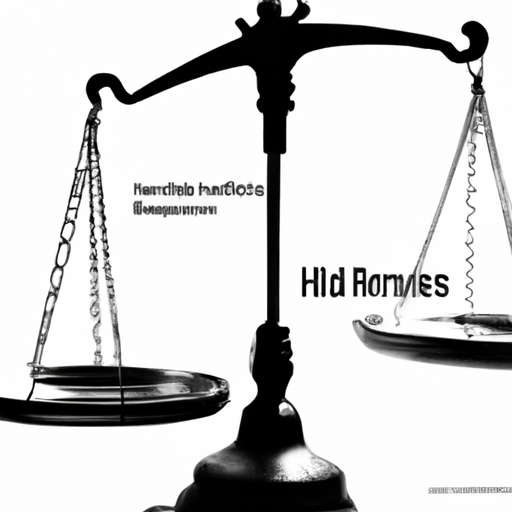In an ever-evolving landscape of legal regulations, it is imperative for businesses to stay ahead of the curve when it comes to HR compliance. Keeping pace with the latest trends is not only vital for avoiding costly penalties and legal disputes, but also for fostering a positive work environment and maintaining a strong reputation. This article will explore some of the key HR compliance trends that companies should be aware of in order to ensure their operations are in line with the law. From changes in employment laws to the increasing emphasis on diversity and inclusion, businesses must proactively address these issues to protect their employees and mitigate potential risks. Stay tuned to discover the top HR compliance trends and gain a deeper understanding of how they impact your organization.

I. Introduction
A. Explanation of HR compliance
HR compliance refers to the process of ensuring that businesses adhere to the laws and regulations set forth by governmental bodies and industry standards in regards to their human resources practices. It involves following guidelines related to employment laws, data privacy, workplace safety, diversity and inclusion, and other areas that impact the well-being of employees. By complying with these regulations, businesses can avoid legal complications, maintain a positive work environment, and protect the rights of their employees.
B. Importance of HR compliance for businesses
HR compliance is crucial for businesses as it helps mitigate legal risks and maintain a positive reputation. Violating employment laws and regulations can result in costly lawsuits, fines, and damage to a company’s brand. Non-compliance with HR regulations can also lead to employee dissatisfaction, turnover, and a decline in productivity. By prioritizing HR compliance, businesses can create a fair and inclusive workplace that attracts and retains top talent, while safeguarding their interests.
C. Overview of HR compliance trends
HR compliance is an ever-evolving field that is influenced by various trends and factors. Some notable trends in recent years include the increasing use of technology, a greater focus on diversity and inclusion, growing concerns about data privacy and security, the rise of the gig economy, the importance of workplace mental health, and the need for work-life balance. As businesses navigate these trends, they must stay informed about the changing landscape of HR compliance to ensure they are compliant with the latest regulations and best practices.
II. Technology-driven Compliance
A. Adoption of HR technology solutions
One of the significant trends affecting HR compliance is the widespread adoption of HR technology solutions. These tools, such as human resource information systems (HRIS) and applicant tracking systems (ATS), streamline HR processes and enable businesses to manage compliance more efficiently. HR technology solutions automate tasks like employee onboarding, time tracking, and benefit administration, reducing the risk of errors and ensuring compliance with employment laws.
B. Automation and streamlining HR processes
Automation plays a crucial role in HR compliance by minimizing the potential for human error and ensuring consistent adherence to regulations. Automated processes can handle tasks like payroll calculations, tax withholdings, and leave management, eliminating the risk of miscalculations or oversights. By streamlining these processes through automation, businesses can maintain accurate records, comply with wage and hour laws, and prevent compliance violations.
C. Data analytics and predictive modeling for compliance
The advancement of data analytics and predictive modeling has revolutionized HR compliance. By analyzing large sets of HR data, businesses can identify trends and predict potential compliance risks. These insights enable proactive decision-making, allowing businesses to address compliance issues before they escalate. Data analytics can also help in measuring the effectiveness of diversity and inclusion initiatives, identifying areas for improvement, and ensuring compliance with equal employment opportunity laws.
D. Artificial Intelligence and machine learning in HR compliance
Artificial Intelligence (AI) and machine learning are transforming HR compliance by enhancing accuracy, efficiency, and decision-making processes. AI-powered tools can analyze vast amounts of data to identify anomalies, patterns, and potential compliance issues. Machine learning algorithms can learn from past compliance cases and provide recommendations for preventive measures. These technologies enable businesses to ensure compliance, detect potential violations, and streamline compliance-related tasks.
III. Diversity and Inclusion Initiatives
A. Increased focus on diversity and inclusion
In recent years, there has been a significant shift towards promoting diversity and inclusion in the workplace. Businesses are recognizing the importance of creating a diverse workforce that reflects the demographics of society and values inclusion. Diversity encompasses characteristics such as race, gender, ethnicity, age, disability, and sexual orientation. Inclusion, on the other hand, involves fostering an environment where all employees feel valued, supported, and have equal opportunities to thrive.
B. Implementing inclusive hiring practices
To promote diversity and inclusion, businesses need to implement inclusive hiring practices. This includes reviewing job descriptions to ensure they are free from bias and actively seeking diverse candidates. Employers should also establish diverse hiring panels and implement blind screening processes to minimize unconscious bias in the hiring process.
C. Training and development programs for a diverse workforce
To create an inclusive work environment, businesses should invest in training and development programs that promote diversity awareness and inclusion. These programs can educate employees on cultural competence, unconscious bias, and effective communication across diverse teams. By fostering a culture of understanding and respect, businesses can ensure that employees from all backgrounds feel valued and included.
D. Monitoring and measuring diversity metrics
To assess the success of diversity and inclusion initiatives, businesses should regularly measure and monitor diversity metrics. This involves tracking employee demographics, representation in leadership positions, and employee satisfaction surveys related to diversity and inclusion. By monitoring these metrics, businesses can identify areas for improvement and ensure ongoing compliance with equal employment opportunity laws.
IV. Data Privacy and Security
A. Changing regulations and requirements
Data privacy and security regulations are constantly evolving, requiring businesses to stay updated and compliant. In recent years, there has been a significant increase in regulations, such as the European Union’s General Data Protection Regulation (GDPR), California’s Consumer Privacy Act (CCPA), and other regional and industry-specific data protection laws. Businesses need to understand these regulations and implement appropriate measures to safeguard employee data.
B. Ensuring data protection and privacy
To comply with data privacy regulations, businesses should implement measures to ensure the protection and privacy of employee data. This includes implementing data access controls, encryption methods, and secure data storage systems. Employers should also establish data breach response plans to effectively handle any potential security incidents and notify affected individuals as required by law.
C. Cybersecurity measures for HR data
In addition to data protection, businesses must prioritize cybersecurity to prevent unauthorized access to HR data. Implementing strong passwords, multi-factor authentication, firewalls, and regular security audits can help mitigate the risk of data breaches. Training employees on cybersecurity best practices, such as recognizing phishing attempts and avoiding suspicious email attachments, is also vital to maintaining data privacy and compliance.
D. Employee consent and data storage limitations
To comply with data privacy regulations, businesses must obtain appropriate employee consent for collecting, storing, and processing their personal information. Employers should clearly communicate the purposes for which the data is being collected and ensure that employees have the option to withdraw their consent if needed. Additionally, businesses should adhere to data storage limitations and only retain employee data for as long as necessary, in accordance with legal requirements.
V. Gig Economy and Disruptive Workforce
A. The rise of gig workers and independent contractors
The gig economy, characterized by the prevalence of temporary and independent workers, has significantly impacted the traditional employment landscape. Businesses are increasingly relying on gig workers and independent contractors for flexibility and cost savings. However, this shift presents compliance challenges, as the legal classification of gig workers and independent contractors differs from that of regular employees.
B. Addressing compliance issues with the gig economy
To ensure compliance with employment laws in the gig economy, businesses must carefully classify their workers. Misclassifying gig workers as independent contractors when they should be considered employees can lead to legal consequences and financial penalties. Consulting with legal professionals who specialize in employment law can help businesses navigate the complexities of gig economy compliance.
C. Updating policies and contracts for gig workers
Businesses should update their policies and contracts to address the unique needs of gig workers. These documents should outline the rights and responsibilities of both parties, clarify the working relationship, and ensure compliance with employment regulations. Companies should also consider providing gig workers with training on relevant compliance matters to promote a safe and productive work environment.
D. Managing compliance risks with a non-traditional workforce
Non-traditional work arrangements require businesses to adapt their compliance practices. This includes revisiting policies related to wage and hour laws, employee benefits, and workplace safety to ensure they accommodate the specific needs of gig workers and independent contractors. Properly managing compliance risks in the gig economy is essential to avoid legal disputes and maintain a positive relationship with contract workers.
VI. Workplace Mental Health
A. Understanding the importance of mental health
Recognizing the importance of mental health in the workplace is crucial for both employee well-being and compliance. Poor mental health can lead to decreased productivity, increased absences, and heightened legal risks for businesses. Prioritizing mental health creates a supportive and inclusive work environment while ensuring compliance with laws that protect employees’ mental health rights.
B. Establishing mental health support systems
Businesses should establish mental health support systems to assist employees who may be struggling with mental health concerns. This includes providing access to Employee Assistance Programs (EAPs), counseling services, and resources for mental health education. By offering these support systems, businesses can help employees cope with mental health challenges and reduce the risk of legal liability related to mental health issues.
C. Implementing mental health policies and programs
To address mental health concerns in the workplace, businesses should implement comprehensive mental health policies and programs. These should include protocols for identifying and addressing mental health issues, promoting work-life balance, and reducing workplace stressors. By incorporating mental health into company policies, businesses can demonstrate a commitment to employees’ well-being and create a positive work environment.
D. Training managers to recognize and address mental health concerns
Managers play a crucial role in supporting employees’ mental health and managing potential compliance issues related to mental health. Businesses should provide training to managers on recognizing signs of mental health issues, responding appropriately, and directing employees to appropriate resources. Empowering managers with the knowledge and skills to address mental health concerns can help create a supportive work culture and prevent legal complications.

VII. Employee Well-being and Work-life Balance
A. Promoting employee well-being
Employee well-being encompasses physical, mental, and emotional health. Promoting employee well-being not only contributes to a positive work environment but also improves compliance with employment laws. Businesses should prioritize employee well-being by offering wellness programs, encouraging work-life balance, and fostering a supportive and healthy workplace culture.
B. Flexible work arrangements and remote work policies
Flexible work arrangements, such as remote work and flexible hours, have become increasingly important in promoting work-life balance and employee well-being. These policies accommodate employees’ personal needs, reduce stress, and increase job satisfaction. To ensure compliance, businesses should establish clear guidelines and processes for flexible work arrangements, including addressing wage and hour laws and providing appropriate tools and technology for remote work.
C. Balancing work and personal life
Achieving a healthy work-life balance is vital for employee well-being and compliance. Businesses should encourage employees to take breaks, use vacation time, and prioritize self-care. This can be achieved through policies that promote work-life balance, such as flexible scheduling, limited work hours, and generous leave policies. By creating a work environment that respects employees’ personal lives, businesses can improve job satisfaction and reduce legal risks associated with work-related stress and burnout.
D. Work-life integration and productivity
Work-life integration recognizes that work and personal life are interconnected, and finding a harmonious balance is essential for employee productivity. Businesses can support work-life integration by offering resources like employee assistance programs, wellness initiatives, and support for caregiving responsibilities. By prioritizing work-life integration, businesses can foster employee engagement, satisfaction, and compliance with labor laws that protect employees’ well-being.
VIII. Compliance with Employment Laws
A. Staying updated with changing employment laws
Compliance with employment laws requires businesses to stay informed about the evolving legal landscape. Employment laws cover areas such as wage and hour regulations, anti-discrimination and harassment guidelines, employee leave entitlements, and accommodation requirements. Regular monitoring of legislative updates and consultation with legal professionals can help businesses stay compliant and avoid legal disputes.
B. Compliance with wage and hour laws
Wage and hour compliance is a significant aspect of HR compliance. Businesses must adhere to minimum wage standards, overtime requirements, and regulations related to employee classification. Properly tracking employee work hours, providing accurate wage statements, and ensuring fair compensation are critical for compliance with wage and hour laws.
C. Anti-discrimination and harassment policies and training
Businesses must have comprehensive anti-discrimination and harassment policies in place to ensure a workplace free from discrimination and harassment. These policies should outline prohibited behaviors, reporting procedures, and consequences for violations. Regular employee training on these policies is essential to promote awareness, prevent discrimination and harassment, and demonstrate a commitment to compliance.
D. Leave and accommodation policies
Compliance with employee leave and accommodation laws is vital to protect employees’ rights and avoid legal issues. Businesses should establish clear policies and procedures regarding employee leave entitlements, such as family and medical leave, paid sick leave, and reasonable accommodation for individuals with disabilities. By adhering to these laws and providing appropriate leave and accommodations, businesses can maintain compliance and support their employees’ well-being.

IX. Workplace Safety and Health
A. Ensuring a safe and healthy work environment
Providing a safe and healthy work environment is not only a legal obligation but also a moral responsibility for businesses. Compliance with workplace safety and health regulations is crucial to prevent accidents, injuries, and illnesses among employees. Businesses should establish comprehensive safety programs, conduct regular inspections, and provide necessary training and protective equipment to ensure compliance and minimize workplace hazards.
B. OSHA compliance and regulations
Compliance with regulations set by the Occupational Safety and Health Administration (OSHA) is essential for businesses to maintain workplace safety. Businesses should familiarize themselves with OSHA standards, conduct regular risk assessments, and implement appropriate safety protocols. OSHA compliance includes maintaining records of workplace injuries and illnesses, providing safety training, and addressing hazards promptly.
C. Workplace wellness programs
Workplace wellness programs promote employee health and well-being, contributing to compliance with workplace safety and health regulations. These programs can include initiatives such as health screenings, stress management programs, and fitness challenges. By investing in employee wellness, businesses can improve overall workplace safety, reduce absences, and enhance compliance with health and safety laws.
D. Handling workplace injuries and accidents
In the event of a workplace injury or accident, businesses must promptly address the incident and provide appropriate support to the affected employee. This includes ensuring the employee receives necessary medical attention, conducting internal investigations, and filing required reports with regulatory agencies. By handling workplace injuries and accidents effectively, businesses can demonstrate their commitment to employee safety and compliance with relevant laws.
FAQs
- What are the consequences of non-compliance with HR regulations?
Non-compliance with HR regulations can lead to severe consequences for businesses. Violations of employment laws can result in costly lawsuits, financial penalties, and reputational damage. Additionally, non-compliance can lead to employee dissatisfaction, turnover, and decreased productivity. It is essential for businesses to prioritize HR compliance to mitigate legal risks and maintain a positive work environment.
- How can HR technology solutions assist with compliance?
HR technology solutions automate and streamline HR processes, reducing the risk of errors and ensuring compliance with employment laws. These solutions can handle tasks such as payroll calculations, time tracking, and benefits administration, minimizing the potential for compliance violations. Additionally, HR technology tools offer data analytics and predictive modeling capabilities, enabling businesses to identify compliance risks and proactively address them.
- What steps can businesses take to promote diversity and inclusion?
To promote diversity and inclusion, businesses can take several steps. This includes implementing inclusive hiring practices, such as reviewing job descriptions for bias and actively seeking diverse candidates. Companies should invest in training and development programs that raise awareness about diversity, educate employees on unconscious bias, and promote effective communication across diverse teams. Monitoring and measuring diversity metrics is also crucial for evaluating the success of diversity and inclusion initiatives.
- What are the key requirements of data privacy regulations?
Data privacy regulations require businesses to protect employee data by implementing appropriate security measures, like access controls and data encryption. Employers must obtain employee consent for collecting, storing, and processing personal information and adhere to data storage limitations. Data breach response plans should be in place to handle security incidents, and businesses must comply with notification requirements. Compliance with data privacy regulations, such as the GDPR and CCPA, helps safeguard employee privacy and avoids legal and reputational risks.
- How can employers address mental health concerns in the workplace?
Employers can address mental health concerns in the workplace by establishing mental health support systems, such as Employee Assistance Programs and counseling services. Implementing comprehensive mental health policies and programs promotes awareness, identifies and addresses mental health issues, and reduces work-related stressors. Training managers to recognize signs of mental health issues and directing employees to appropriate resources is essential. By prioritizing mental health, employers can create a supportive work environment and comply with laws protecting employees’ mental health rights.



































